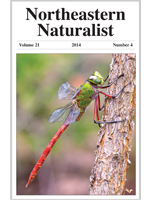Aquatic herbicides are applied to control nuisance vegetation in lakes and ponds, and are often re-applied over many years. This study compared the abundance of 5 frog species in treated and untreated lakes in Ashburnham, MA. At each lake, I assessed the density of human housing and lake area to determine their relationship with frog abundance. I employed a standard calling index to estimate the abundance of each frog species and the sum of calling indices from all species served as a measure of total frog abundance at each survey site. The sum of calling indices declined with increasing density of human housing; herbicide treatment was not an important main effect. However, there was marginal interaction between herbicides and housing density: lakes with moderate—high housing densities seemed to have lower frog abundance with herbicide treatments. Although the data set was limited, my results suggest that frogs may benefit from permanently untreated refuge zones on lakes. When I assessed frog species individually, only Rana clamitans (Green Frog) was less common as housing density increased. None of the 5 frog species were less abundant in herbicide-treated lakes. In my study, long-term use of aquatic herbicides did not generally reduce abundance of adult frogs, but more studies may be needed to determine whether some herbicides may impair frog populations that are already stressed by housing development.
How to translate text using browser tools
1 March 2015
Effects of Aquatic Herbicides and Housing Density on Abundance of Pond-Breeding Frogs
Chris Picone
ACCESS THE FULL ARTICLE

Northeastern Naturalist
Vol. 22 • No. 1
March 2015
Vol. 22 • No. 1
March 2015




